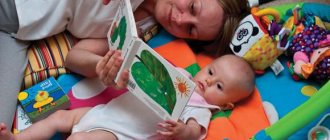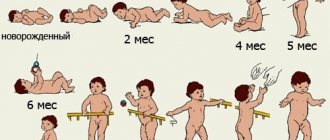Baby development at 5 months: sleepy kingdom
Most babies are already sleeping through the night by 5 months.
But still not everything. To get your baby accustomed to a normal sleep schedule, create a routine for going to bed. Start with a warm bath in the evening, after which you rock your baby for a while, sing him a song or tell him a story. Remember to put your baby to bed when he or she falls asleep, not when he or she is already asleep. In this case, the child will be forced to learn to fall asleep on his own, and not always rely on your help.
During the day, five-month-old babies usually sleep twice, little by little - once in the morning and again in the afternoon. Try not to put off taking a short nap until your baby is tired and fussy. Put your baby in the crib at the first sign of sleep.
Child's social and emotional development
Every child is a society, he lives among people and in the world of people. For contrast, let's remember the children's cartoon about Mowgli. Everyone knows perfectly well what happened to the human cub when he found himself among the animals.
From birth, a small child needs to communicate with adults. By surrounding him with care and attention, parents, without noticing it themselves, have a great influence on the social and emotional development of the baby.
By the age of five months, the baby already gives his first smile to his loved ones and knows how to laugh contagiously.
Despite his foolish age, at five months he can distinguish his own people from strangers. His body and emotions speak about this: when he sees people caring for him, the baby relaxes and rejoices; he reacts tensely to strangers, and sometimes with negative emotions. But if an unfamiliar adult speaks kindly, the baby immediately reacts positively, and wariness is replaced by a smile.
The same reaction is observed in a child when he finds himself in an unfamiliar environment. In this situation, the presence of a loved one nearby is necessary.
What color is the world around you?
During a baby's developmental stage of five months, his vision continues to improve. Of course, at this age it is not yet 100% in children, but they can already see objects at different distances and can focus their vision without squinting their eyes.
The baby's color perception changes radically! If at 4 months a toddler is already able to notice a large red button on a red fabric (that is, he is already able to distinguish volume and texture in one color scheme), then by 5 months the child can quite freely distinguish several shades of the same color. Although children under the age of six months still react most to bright, contrasting colors - red, blue, yellow.
Fine motor skills
The baby is growing and his development does not stand still. Exercises for grasping and holding toys contribute to the development of hand-eye coordination in children. Touching low-hanging toys and grasping them with both hands, the baby begins to study them: he feels and throws or examines them.
The development of motor skills of the hands and fingers throughout preschool childhood requires special attention. The child’s speech and logical thinking depend on how well it is developed!
At this age, it is necessary to teach a child to take a toy from the hands of an adult, not only while in the arms of mom or dad, but also from a lying position on his stomach and back.
Anastasia, mother of two children: “My eldest son did not want to talk for a long time. After consulting with a speech therapist, I was recommended many games and exercises aimed at developing motor skills. The specialist said that all our speech, oddly enough, is at our fingertips.”
Speech development of a child at 5 months
At the developmental stage of 5 months, the child is already babbling with all his might. And some of the sounds made may even sound like words. A five-month-old baby is able to add vowels and consonants (something like “ba-ba”). Don't get too excited when you hear something that sounds like "pa-pa" or "ma-ma." These are just sounds; at such a young age, children do not assign any meaning to such sounds. Wait a couple of months, and these “pa-pa” and “ma-ma” will already acquire exactly your features in the mind of the talkative little one.
By the way, the world for a 5-month-old baby takes on new shades not only due to the development of color perception, but also because the baby begins to distinguish the nuances of all kinds of sounds. For example, if previously for him a dog barking and a car alarm were a single auditory stimulus, now these sounds are perceived differently in the child’s mind.
Gradually, the baby begins to “get carried away” with sounds - to recognize them and react to them differently. Some sounds clearly entertain him - they make him laugh, surprise, delight. He may not like others - the child frowns “in response” to them, becomes capricious, and may even cry. As a rule, the most pleasant sound for a child is the melodious voice of his mother...
How to direct your child's wakefulness and sleep patterns in the right direction?
Sometimes it happens that a child confuses day and night. You go to bed, and after one o'clock in the morning your baby wakes up and begins an active life: he babbles something, knocks with his hand on the rattles suspended above him, begins to crawl in the crib... And dad has to work early in the morning, and, having woken up, he no longer can fall asleep, gets nervous, gets angry. Mom also wants to rest; for her, night rest is even more important: after all, she is breastfeeding the baby; and if mom chronically does not get enough sleep, her milk may disappear... Be patient. Don't swear at your child. Moreover, he still does not understand what they want from him. Don't even raise your voice at him - you'll only scare him.
Try to find irregularities in the already established routine of day and night. Think about it: why does a child already feel rested and looking for communication by one or two in the morning? Perhaps your child sleeps too much during the day because no one is studying with him. This is one of the most likely reasons. The child is left to his own devices, he is tired of the toy that lies in the crib, and he does not even look at this toy. And without playing, without moving, he does not get tired.
There is another important point: sometimes someone close to you plays too actively with the child at night and overstimulates him. For example, dad: came home from work, had dinner, rested a little on the ottoman and then decided to play with the heir. And he shakes the baby, and laughs, and spins, and even throws him up to the ceiling. The child obviously likes this. But after such fun he cannot sleep at night.
Some parents (let's hope there are few of them), getting irritated with their child for any reason, hit him. In all likelihood, not much - but still! Such a child, of course, will sleep restlessly and wake up at night, incurring even greater anger from his stupid parents.
Your child is four months old, he has grown up after the maternity hospital - even you notice this, although you see the child every day. However, your baby is still too weak and requires careful handling - always remember this. When you pick up a child, hold him correctly so as not to damage or bend the spine - he is still so tender. Your child should already be able to hold his head up well.
If you need to hold the baby in your arms, then let him lie with his shoulder blades and back on your forearm, and hold his lower body with your free hand. Don't restrict his movements. The baby wants to move his arms and legs - let him move; If he wants to stretch, let him stretch; his muscles may have become stiff from lying for a long time, and it’s so nice to stretch.
But don't hold him in your arms all the time. This will only harm both yourself and the child. But he should not remain alone and lie in one place all the time. Be sure to buy a playpen, you can move it around the apartment, and the baby will always see his loved ones, and your hands will be free for other things.
Your child becomes very curious. He can no longer lie quietly in place. He turns his head back and forth, examines objects, and tries to reach them. Sometimes he even tries to sit up. This is, of course, a reason to rejoice for parents. But don’t rush to sit your child down. If the child has not yet sat down on his own, it means that he is not ready to sit (the spine is not strong enough, the back muscles are not strong enough). Sometimes parents cover the child with pillows so that he can sit. Do not do this. Rushing can cause harm. Nature will prepare the child’s body, and he will sit up on his own.
However, sometimes you can kind of help the baby sit down. This will be a kind of game that strengthens the child’s back muscles. You offer him your fingers, he grabs them and tries to sit up. Let him sit for a second and put him down again. Come back to this game from time to time.
After the age of four months, do not restrict the baby’s movements in any way. Let him jerk his legs and arms to his own pleasure. This is necessary for proper physical development.
Turn the baby from side to side, lay him on his tummy. You will notice how, while lying on his stomach, your child arches his back, turns his head left and right - perhaps these movements occur because the child does not want to lie with his nose buried in the sheet. From these movements, the muscles of the back and neck quickly become stronger. You can please your baby with a light back massage. Children really like massage.
Change your baby's position often when he is lying in the crib. Sometimes he sleeps on his left side, sometimes on his right; When awake, he will lie on his back. Such a change in body position is important because congestion in the muscles is eliminated in time, and therefore the muscles do not become too tired. In addition, the child’s head is not deformed (sometimes some flattening of the back of the head is observed when the body is positioned uniformly on the back).
You can already assess the psychophysical development of your child yourself. At the age of four months, a child can normally do the following: - lying on his stomach, turns on his side; - when you pick him up, he holds his head well; - when he lies on his back, sometimes he raises his head and tries to sit up on his own; - while awake, actively moves arms and legs, grabs all objects that are nearby; - lying on his stomach, rests his hands on the mattress and slightly raises his torso; - is very interested in everything that happens around him; looks around, recognizes the voice, responds with a smile; determines where the sound source is and tries to turn towards it; - tries out his voice, babbles, laughs; - is very interested in toys, expresses joy when a new toy appears; - if music starts playing in the next room, the child freezes and listens with curiosity.
There is a pattern: the more care and attention you show to your child, the better he develops psychophysically. You are the source from which the baby draws. You must be open. Don't be lazy, do more with your baby. Talk to him, sing him songs - and not just lullabies; show toys, name colors, draw bright pictures. A child is like a sponge, he absorbs all impressions. Perhaps he is not yet able to demonstrate the stock of his knowledge, but rest assured - something has been put aside.
You have noticed more than once that a child babbles. The sounds he utters do not yet carry any meaning. This is only a voice test, a test of the speech apparatus. It will take him a long time to learn to speak and memorize new words and is still only at the beginning of his journey. Folding your lips in a certain way, pressing your tongue against your gums and making a certain sound is so interesting. This is an entertaining game for a child. Take part in this game, set the tone - pronounce different sounds, but so that the child can see your lips.
Talk to your child in a calm voice. He feels more confident when he sees that you are calm. This is inherent in nature: a child is a small mirror of your condition. If you are worried about something, your child will quickly notice and become worried too.
When talking to your child, point to the objects you name. In the future, this knowledge will help the child speak faster.
But don’t forget about a sense of proportion. Don't tire your baby too much. The limits of his capabilities are still very small. By being too active with such a small child, trying to make him a child prodigy to please your own ambition, you can only do harm.
If you notice that your child has lost interest in the subject of the conversation, do not overdo it. The child was simply tired - he was filled to capacity with impressions. He needs some time to digest these impressions.
Some mothers act wisely, starting from the fifth month to accustom their baby to a cup. One or two sips of boiled water from a cup is all that is required to get started. But this will significantly expand the child’s horizons. The baby will already know that food can be taken not only from the breast or bottle. Over time, it will be easier for you to wean your baby.
First, you hold the cup yourself and press its edge to the child's lips. Then you give the cup into the child’s hands—for example, a plastic cup (if the child lets it go, he won’t break it). So gradually the baby will learn to handle the cup on his own.
Show your baby how you drink from a cup yourself. The object lesson meant a lot to him.
Of course, the child will spill the contents of the cup on himself more than once. No one gets by without such “accidents.” Control yourself, don’t get angry with your child, don’t yell at him, make an effort on yourself and stay calm. Change your child's clothes and talk to him like an adult. Children of all ages love to be treated like adults. And, perhaps, there is no child in the world who would love to be coddled (why do some adults think that children should be talked to this way?).
Stick to your child's chosen daily routine. The body loves rhythm. By adjusting to the rhythm, the child’s body, as it were, predicts itself for the near future and prepares for it. With such preparation, the course of many physiological processes is greatly facilitated.
Useful tips
- As early as 5 months, children begin to actively respond to music. Play melodies of various genres for your baby, from classical and jazz to pop music. The child will smile, wave his arms, and maybe even make sounds, following the beat of the melody.
- A 5-month-old child is very curious and willingly examines new objects. Every time you give him something in his hands, say the name clearly and loudly, like: “This is a ball,” “This is a rabbit,” “This is your hat.” This will help the baby speak faster, train his memory, and help him learn to quickly recognize various objects by their names.
- Remove hanging toys from the crib. As soon as the baby learns to stand on his own legs and hold the side of the bed, he may become entangled in them.
- By the age of 5-6 months, the child shows noticeable interest when seeing himself in the mirror. Don't deprive him of this pleasure - get him a toy that has a safe mirror.
- If you still haven't made your apartment safe for your child, take care of it. Conceal all electrical outlets, remove cleaning products and generally any objects or substances that may be dangerous from reach. Including small parts that could cause a child to choke. Do not forget to promptly remove cups with hot drinks or switched-on irons with dangling cords - your child is quite capable of yanking them off the table.
Sleeping, feeding and waking patterns
The calmness and cheerfulness of a 5-month-old baby directly depends on caring for him and satisfying his natural needs: sleep, eating and leisure. In the first nine months, it is very important to follow this sequence.
Dream
Throughout the day, the baby sleeps 3-4 times, the duration of daytime sleep is 1.5-2 hours, and night sleep is 10 hours.
In order for the child to sleep soundly, parents must create appropriate conditions: the room must be clean, and regular ventilation is mandatory.
Calm and sedentary games are recommended before bedtime. For example, sing a lullaby or, stroking the baby’s back, give a kind of relaxing massage.
You should not teach your baby to fall asleep in complete silence in the apartment and resort to any additional influences, for example, a pacifier or rocking.
Feeding
Five-month-old babies eat 6 times a day, the intervals between feedings are 3.5 hours.
The main food for babies at 5 months is mother's milk or special infant formulas, which are prescribed by a pediatrician. During feeding, the baby develops basic self-service skills: he independently takes, holds and brings the bottle to his mouth. From 5 months, you can already teach your child to drink from a mug that an adult holds in his hand.
According to WHO, the first complementary foods are introduced to children from six months. Children of five months are on the threshold of this age, so parents should now think about a varied diet for the baby.
Katya, mother of Artem 5 months: “I breastfeed my son. Recently I began to notice that during feeding he nervously twitches his nipple, after which he begins to cry. I informed the pediatrician about this, he suggested that Artem might not be eating enough, and suggested starting to introduce complementary foods.”
Wakefulness
Waking hours become long and increase to 1.5-2 hours.
Despite the fact that the baby is small and unintelligent, do not leave him alone with his toys. With each new day, the child develops and learns about the world around him.
What a child should be able to do at 5 months: skills in a nutshell
5 months in a child’s development is such an important and touching period when gradually from a tiny helpless lump the baby begins to turn into a fairly mobile and sociable person. Let’s summarize in a nutshell what a 5 month old baby should be able to do :
- The child already knows how to roll over from his back to his tummy, and perhaps even back;
- If you hold the baby by the arms, but he is able to stand on his legs for several seconds;
- With back support, the child can sit for a long time. Some children already know how and love to sit up, holding on to the “handles” or the side of the crib;
- From several toys, a child is able to choose first one, then another;
- Confidently holds objects with both hands;
- A child at 5 months recognizes several shades of the same color and also distinguishes sounds;
- The baby “loves” to make all kinds of sounds and syllables. However, the conscious first words are still to come.
Proper care for a five month old baby
The baby becomes active and mobile and should not be left unattended. The child already knows how to roll over, tries to crawl and may fall off the sofa or changing table.
Baby skin care and hygiene
Since the baby is active during this period, you may notice a manifestation of this “activity” on the skin - there may be redness in the groin, axillary area, on the back, legs. There is no need to panic, just follow some rules.
- Do not wrap your child up: the baby moves a lot, and the thermoregulation of the skin is still weak, so heat rash may appear. If the ambient temperature is comfortable, keep your baby naked.
- Choose clothes carefully, check whether the seams on your baby’s clothes are chafing, especially in the armpit and groin area, as well as on bedding. All items of clothing for a child should be made from natural fabrics.
- If possible, avoid using diapers.
- After each diaper change, wash your baby or wipe with a damp cloth or towel.
Signs of heat rash in a baby - redness of the skin and rashes in the form of small pimples
If you notice prickly heat - this is usually redness of the skin and rashes in the form of small pimples, first of all, think about the possible reasons: room temperature, clothing, and so on, in order to avoid this manifestation in the future. Treatment of prickly heat is possible with:
- baths with string, chamomile, yarrow;
- disinfectants, for example, 1–2% solution of boric or salicylic acid;
- baby powder and creams containing boric acid, zinc, panthenol.
As before, after waking up, it is necessary to carry out water procedures for the baby - wash the face, eyes, clean the nose and ears as they become dirty.
Nutrition
Breast milk remains the main type of food a child receives at this age. Pediatricians for children 5 months of age advise, as before, 5-6 meals a day, on average every 3-3.5 hours. The total volume of food is no more than 1 liter.
Most healthy breastfed babies have no need for other sources of energy and nutrients other than mother's milk until they are 6 months old. Everything a baby needs to grow and develop is found in breast milk (including water). Certain patterns of development and maturation of the digestive system do not allow the full absorption of another type of nutrition.
Experts' opinions on the timing of introducing complementary foods vary greatly; some allergists are inclined to argue that the first types of complementary foods should be introduced into the diet only after eight months, as this reduces the risk of allergic reactions in children.
To date, there is no consensus on the timing of the start of complementary feeding. From the point of view of most authoritative experts on child nutrition:
- introduction of complementary foods at the age of about 6 months is optimal;
- the advisability of starting complementary feeding at 4 months is questionable;
- Starting complementary feeding before 4 months is definitely and categorically wrong.
E.O. Komarovsky
https://articles.komarovskiy.net/prikorm-sroki-i-pravila.html
Artificial children begin to be given complementary foods 1–2 months earlier. Their digestive tract is already familiar with foreign products - adapted milk formulas - and is earlier ready to assimilate new things. The period for introducing complementary foods is determined by the pediatrician together with the mother; as a rule, it is 4–5 months. Along with complementary foods, they begin to give water (the required volume is 50 ml per day).
From the age of five months, a child can already receive complementary foods in the form of vegetable purees.
Complementary feeding usually starts with vegetable monocomponent puree, and zucchini or cauliflower is usually recommended as the first vegetable. After about a month, the next complementary food is introduced - porridge. It’s better to start with dairy-free ones, since they have minimal allergenicity. The most common choice is buckwheat porridge. Start with 1 teaspoon, increasing the amount per dose to 150 grams by the end of the fifth month. Porridge is usually prepared using a mixture familiar to the child (sometimes using vegetable broth).
Product options for introducing complementary foods - photo gallery
Dairy-free porridge is less allergenic
Cauliflower is rich in vitamins and minerals and practically does not cause allergic reactions.
Zucchini is easily digestible and hypoallergenic
How to bathe a baby
By the age of five months, the baby is already accustomed to water procedures, he likes to be in the water, parents can increase the duration of bathing. If in previous months the child was bathed relatively quickly, then during this period take with you toys that the baby can hold in his hands, wave them, creating a lot of water splashes around him. The average duration of stay in water is from 15 to 20 minutes. Water temperature 32–37 0С.
The child does not yet know how to sit, but everything that is around arouses great interest in the baby. The baby is very active, so you need to constantly hold him when bathing. Today, many mothers use special slides for swimming, of which there are quite a few varieties: foam rubber, plastic, fabric and others. If you do not use special devices, you can put cloth or gauze on the bottom of the bath to make the baby comfortable and safe.
On a special slide it is convenient for the baby to sit in the bathtub
Parents are faced with the problem of not having enough space to bathe their baby in a small baby bathtub and often ask if it is possible to bathe him in a large bathtub shared by the rest of the family. No one prohibits the use of an “adult” bath, so if the baby is not afraid, feel free to place it in a larger space, of course, with disinfection measures and utmost safety.
Dream
If a month ago the baby could sleep 18 hours a day, now his physical activity has increased and there is less time for sleep. A child's daytime sleep should be up to 6 hours. This is usually 1.5–2 hours between main feedings. In general, a 5-month-old baby sleeps 14–16 hours a day. It is important to follow a daily routine and try to put your baby to bed at the same time.
At 5–6 months of age, the baby sleeps 14–16 hours a day
How to massage
Massage for a five-month-old baby is necessary, as before. Now the purpose of it is to prepare the baby for crawling, rolling over, sitting and walking. Therefore, all actions should be aimed at strengthening and developing the muscles of the back, abdomen and legs. The massage session lasts 15–30 minutes, the movements should be more intense than a month ago, but not cause pain or discomfort in the child. During the session, you can recite poems, sing songs and count. It is better to choose lunch or evening time for classes. At the age of 5 months, the need for facial massage also appears - the baby becomes more emotional, and the load on the facial muscles increases.
During the massage, it is necessary to encourage the child to roll over and crawl, doing special exercises.
How to massage a 5 and a half month old baby - video
Psycho-emotional progress
The fifth month of baby development is characterized by the appearance of new emotions. It can express joy and sadness, anxiety and fear. The child becomes an increasingly active participant in communication and an active explorer of the world and himself.
- The baby distinguishes the speech of an adult by intonation: he is happy when he is addressed tenderly and affectionately, but may be offended if his voice is raised sternly. Distinguishes the facial expressions of those speaking to him.
- He listens attentively when spoken to and tries to attract the attention of adults.
- Recognizes familiar faces, perceiving the entire image of an adult: with facial features, hairstyle, voice.
- Knows how to laugh, get angry, demand. Expresses emotions not only through facial expressions, but also through intonation.
- Likes to look at images of faces in pictures or photographs.
- In the absence of the mother, he becomes wary and may become frightened when left with strangers.
- Can remember the toy he liked by color, shape, size, tactile sensations, and distinguishes it from others.
- If you completely cover a toy with something in front of him, he still can’t find it. But if it is not completely covered, the baby can already find it.
- He may not only take a toy when it is given to him, but also take it away.
- For about 10 minutes, the baby is able to occupy himself with playing with an object.
- Likes to involve parents in simple games (throwing a ball for them to pick up, playing peek-a-boo).
- Finds a new object of his body for active study: legs. He spends a long time feeling them and licking them.
Now the baby can laugh loudly. Develop this emotion of his by making funny faces, clicking your tongue, puffing out your cheeks.











